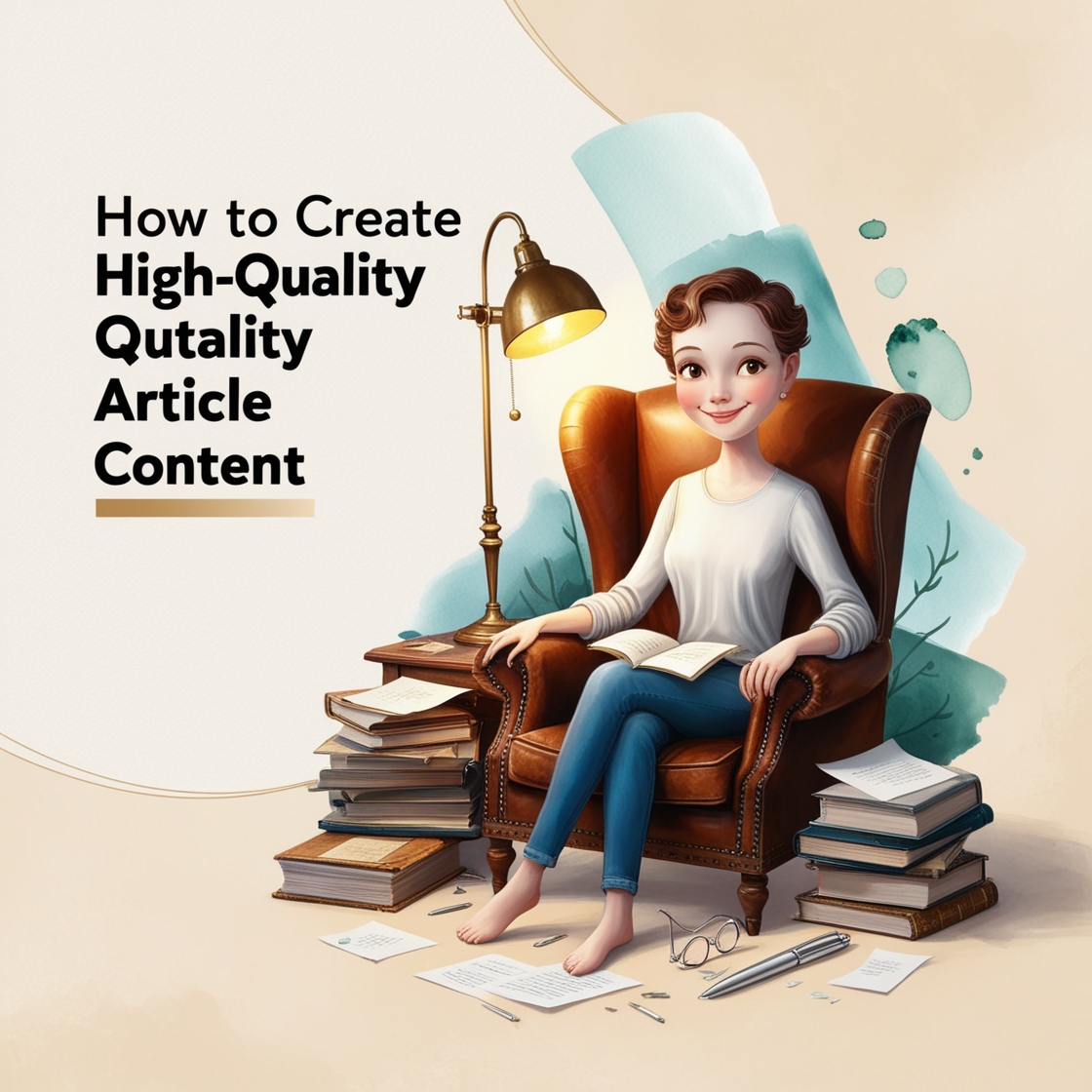

High-quality article content creation

How to Create High-Quality Article Content
Are you tired of creating content that falls flat and fails to engage your audience? 🤔 In today's digital landscape, producing high-quality article content is more critical than ever. With millions of articles published daily, standing out from the crowd can feel like an insurmountable challenge.
But fear not! The secret to crafting compelling, shareable content lies in understanding the art and science behind effective article creation. From knowing your target audience to mastering SEO best practices, there's a world of strategies waiting to transform your writing from mediocre to magnificent. 🌟
In this comprehensive guide, we'll walk you through the eight essential steps to elevate your content game. Whether you're a seasoned writer looking to refine your skills or a newcomer eager to make your mark, you'll discover actionable tips and insights to create articles that captivate, inform, and inspire. Ready to unlock the potential of your content? Let's dive in!
Understanding Your Target Audience
Creating high-quality article content begins with a deep understanding of your target audience. By knowing who you're writing for, you can tailor your content to meet their specific needs and interests, ensuring your articles resonate with readers and provide real value.
A. Identifying reader demographics
To create content that truly connects with your audience, start by identifying key demographic information:
-
Age range
-
Gender distribution
-
Education level
-
Professional background
-
Geographic location
This data can be gathered through:
-
Audience surveys
-
Social media analytics
-
Website traffic analysis
-
Customer feedback
B. Tailoring content to audience needs
Once you have a clear picture of your audience, customize your content to address their specific requirements:
| Audience Characteristic | Content Adaptation |
|---|---|
| Age range | Adjust tone and cultural references |
| Education level | Determine appropriate complexity |
| Professional background | Include relevant industry examples |
| Geographic location | Consider regional preferences and issues |
C. Analyzing reader interests and pain points
To create truly engaging content, dig deeper into your audience's interests and challenges:
-
Conduct keyword research to identify popular topics
-
Monitor social media conversations and trending hashtags
-
Analyze competitors' content and reader engagement
-
Use tools like Google Trends to spot emerging interests
By addressing these pain points and interests in your articles, you'll create content that not only attracts readers but also provides genuine value, establishing your expertise and building trust with your audience. This approach sets the foundation for creating high-quality article content that resonates with your target readership.
Conducting Thorough Research
Now that we've identified our target audience, let's dive into the crucial step of conducting thorough research for creating high-quality article content.
Staying up-to-date with industry trends
To produce top-notch content, it's essential to keep your finger on the pulse of your industry. Here are some effective ways to stay informed:
-
Subscribe to reputable industry newsletters
-
Follow thought leaders on social media platforms
-
Attend webinars and virtual conferences
-
Participate in online forums and discussion groups
Organizing research findings effectively
Proper organization of your research findings is key to creating high-quality article content. Consider using the following methods:
-
Mind mapping
-
Digital note-taking apps
-
Spreadsheets for data comparison
-
Bookmark managers for web resources
Fact-checking and verifying information
Ensuring the accuracy of your content is crucial for maintaining credibility. Here's a simple process for fact-checking:
-
Cross-reference information from multiple sources
-
Verify data with primary sources when possible
-
Use fact-checking websites for general claims
-
Consult subject matter experts for complex topics
Identifying credible sources
Not all sources are created equal. Use this table to help you distinguish between credible and less reliable sources:
| Credible Sources | Less Reliable Sources |
|---|---|
| Peer-reviewed journals | Personal blogs |
| Government websites | Social media posts |
| Reputable news outlets | Anonymous websites |
| Academic institutions | Outdated publications |
By following these research practices, you'll build a solid foundation for creating high-quality article content. Next, we'll explore how to craft an engaging structure that will keep your readers hooked from start to finish.
Crafting an Engaging Structure
Now that we've covered the importance of understanding your audience and conducting thorough research, let's dive into crafting an engaging structure for your article. A well-structured article not only captivates readers but also enhances the overall quality of your content.
Creating a Compelling Headline
Your headline is the first thing readers see, making it crucial for grabbing attention. Here are some tips for crafting compelling headlines:
-
Use power words to evoke emotion
-
Include numbers or statistics when relevant
-
Keep it concise and clear
-
Address the reader's pain points or desires
Developing a Strong Introduction
A strong introduction sets the tone for your entire article. Consider these elements:
-
Hook the reader with a thought-provoking question or statement
-
Briefly outline the problem or topic you'll address
-
Explain why the reader should care about the content
-
Provide a clear thesis statement
Organizing Main Points Logically
To ensure your article flows smoothly, organize your main points in a logical manner. Here's a comparison of different organizational structures:
| Structure | Best Used For | Example |
|---|---|---|
| Chronological | Step-by-step guides | "5 Steps to Launch Your Blog" |
| Problem-Solution | Addressing specific issues | "Overcoming Writer's Block: 3 Proven Strategies" |
| Comparison | Analyzing multiple options | "WordPress vs. Wix: Which is Better for Beginners?" |
| Cause-Effect | Exploring relationships | "How Social Media Impacts Mental Health" |
Choose the structure that best suits your topic and audience's needs.
Writing Impactful Conclusions
End your article on a strong note with these conclusion-writing techniques:
-
Summarize key points without repeating verbatim
-
Provide actionable takeaways or next steps
-
Encourage reader engagement through questions or calls-to-action
-
Circle back to the introduction to create a sense of closure
By focusing on these elements of structure, you'll create high-quality article content that engages readers from start to finish. Next, we'll explore how to master the art of writing to further enhance your content's impact.

Mastering the Art of Writing
Now that we've established a solid structure for our article, let's delve into the heart of content creation: mastering the art of writing. This crucial step will transform your well-researched ideas into compelling content that resonates with your audience.
A. Balancing informative and entertaining content
Creating high-quality article content requires striking the perfect balance between information and entertainment. Here's how to achieve this:
-
Provide valuable insights while maintaining reader engagement
-
Use a mix of facts, anecdotes, and relatable examples
-
Incorporate humor or conversational tone where appropriate
B. Incorporating storytelling techniques
Storytelling is a powerful tool for creating memorable content. Consider these techniques:
-
Use a narrative arc to structure your article
-
Create relatable characters or scenarios
-
Employ descriptive language to paint vivid pictures
C. Using clear and concise language
Clarity is key in high-quality article content creation. Follow these guidelines:
-
Avoid jargon and complex terminology
-
Use active voice for more impactful writing
-
Break down complex ideas into digestible chunks
D. Developing a unique voice and style
Your writing style sets you apart from other content creators. Here's how to develop your unique voice:
| Aspect | Tips |
|---|---|
| Authenticity | Be genuine and true to your personality |
| Consistency | Maintain a consistent tone across your content |
| Experimentation | Try different writing styles to find what works best |
By mastering these writing techniques, you'll be well on your way to creating high-quality article content that captivates and informs your readers. Next, we'll explore how to enhance the readability of your carefully crafted content.

Enhancing Readability
Now that we've mastered the art of writing, let's focus on making our content more accessible and engaging for our readers. Enhancing readability is crucial for creating high-quality article content that keeps your audience interested and coming back for more.
Using subheadings and bullet points
Subheadings and bullet points are powerful tools for organizing your content and making it easier to scan. They help readers quickly find the information they're looking for and understand the structure of your article. Here are some benefits of using these elements:
-
Improved navigation
-
Enhanced visual appeal
-
Better retention of information
-
Easier comprehension for readers
Optimizing paragraph length and sentence structure
To keep your readers engaged, it's essential to optimize your paragraph length and sentence structure. Here are some tips:
-
Keep paragraphs short (3-5 sentences)
-
Vary sentence length to maintain rhythm
-
Use active voice for clarity and directness
-
Begin with topic sentences to guide readers
Breaking up text with images and infographics
Visual elements can significantly enhance the readability of your content. Consider incorporating:
| Visual Element | Purpose |
|---|---|
| Images | Illustrate concepts and break up text |
| Infographics | Present complex information visually |
| Charts | Display data in an easy-to-understand format |
| Screenshots | Provide visual examples or instructions |
Incorporating relevant examples and case studies
Examples and case studies bring your content to life and make it more relatable to your readers. They help illustrate complex concepts and provide real-world context for your ideas. When incorporating examples:
-
Choose relevant and recent cases
-
Explain how they relate to your main points
-
Use a mix of well-known and niche examples
-
Provide actionable takeaways from each case study
By implementing these readability-enhancing techniques, you'll create high-quality article content that not only informs but also engages your audience effectively. Next, we'll explore how to implement SEO best practices to ensure your well-crafted content reaches its intended audience.

Implementing SEO Best Practices
Now that we've covered the essentials of creating engaging and readable content, let's dive into the crucial aspect of optimizing your article for search engines. Implementing SEO best practices is key to ensuring your high-quality article content reaches its intended audience.
A. Internal and External Linking Strategies
Effective linking strategies can significantly boost your article's SEO performance:
-
Internal links: Connect your article to other relevant pages on your website
-
External links: Reference authoritative sources to support your claims
| Link Type | Benefits | Best Practices |
|---|---|---|
| Internal | Improves site navigation, distributes page authority | Use descriptive anchor text, link to relevant content |
| External | Builds credibility, provides additional value | Choose reputable sources, use nofollow tags when necessary |
B. Creating SEO-friendly Meta Descriptions and Title Tags
Optimize your article's visibility in search results with compelling meta descriptions and title tags:
-
Meta descriptions: Write concise, engaging summaries (150-160 characters)
-
Title tags: Craft descriptive, keyword-rich titles (50-60 characters)
C. Optimizing Content for Target Keywords
Incorporate your target keywords naturally throughout your article:
-
Use keywords in headings, subheadings, and first paragraph
-
Maintain a keyword density of 1-2%
-
Include variations and long-tail keywords
D. Conducting Keyword Research
Before writing, identify relevant keywords to target:
-
Use keyword research tools (e.g., Google Keyword Planner, SEMrush)
-
Analyze search volume and competition
-
Consider user intent behind search queries
By implementing these SEO best practices, you'll enhance the visibility and reach of your high-quality article content. Next, we'll explore the critical steps of editing and proofreading to ensure your optimized content is polished and error-free.

Editing and Proofreading
Now that you've crafted your article, it's time to refine and polish your work. Editing and proofreading are crucial steps in creating high-quality article content. Let's explore some effective strategies to ensure your article shines.
A. Using editing tools and software
Leverage technology to enhance your editing process:
-
Grammar checkers: Tools like Grammarly or ProWritingAid can catch common errors and suggest improvements.
-
Readability analyzers: Use software like Hemingway Editor to assess and improve your content's readability.
-
Plagiarism detectors: Ensure originality with tools like Copyscape or Turnitin.
| Tool Type | Examples | Benefits |
|---|---|---|
| Grammar Checkers | Grammarly, ProWritingAid | Catch grammatical errors, improve style |
| Readability Analyzers | Hemingway Editor, Readable | Enhance clarity and simplicity |
| Plagiarism Detectors | Copyscape, Turnitin | Ensure content originality |
B. Peer review and feedback
Collaborate with others to gain fresh perspectives:
-
Share your article with colleagues or fellow writers
-
Join writing groups or forums for constructive criticism
-
Consider hiring a professional editor for in-depth feedback
C. Self-editing techniques
Refine your work with these self-editing strategies:
-
Read your article aloud to catch awkward phrasing
-
Take breaks between writing and editing to approach with fresh eyes
-
Use a checklist to systematically review grammar, style, and content
-
Focus on eliminating unnecessary words and tightening sentences
By implementing these editing and proofreading techniques, you'll significantly improve the quality of your article content. Next, we'll explore effective strategies for promoting and distributing your polished work to reach your target audience.

Promoting and Distributing Content
Now that you've created high-quality article content, it's time to ensure it reaches your target audience effectively. Let's explore various strategies to promote and distribute your content for maximum impact.
A. Repurposing content for different formats
Repurposing your article content allows you to reach a wider audience and maximize the value of your work. Consider the following formats:
-
Infographics
-
Podcasts
-
Video tutorials
-
Social media posts
-
Slideshows
| Original Format | Repurposed Format | Benefits |
|---|---|---|
| Long-form article | Infographic | Visual appeal, easily shareable |
| Blog post | Podcast episode | Reaches audio-focused audience |
| How-to guide | Video tutorial | Demonstrates steps visually |
| In-depth analysis | Social media thread | Increases engagement on platforms |
B. Collaborating with influencers and thought leaders
Partnering with influencers and thought leaders in your industry can significantly boost your content's reach and credibility. Try these collaboration methods:
-
Guest posting on their platforms
-
Inviting them to contribute to your content
-
Co-creating content together
-
Asking for expert quotes or insights
C. Email marketing strategies
Email remains a powerful tool for content distribution. Implement these strategies:
-
Segment your email list based on reader interests
-
Create compelling subject lines to increase open rates
-
Include snippets or teasers of your content to encourage click-throughs
-
Personalize emails using subscriber data
-
Use automation to send timely, relevant content
D. Leveraging social media platforms
Social media is crucial for content promotion. Here's how to make the most of it:
-
Tailor content for each platform (e.g., short snippets for Twitter, visual content for Instagram)
-
Use relevant hashtags to increase discoverability
-
Engage with your audience through comments and direct messages
-
Utilize platform-specific features like Instagram Stories or LinkedIn Articles
-
Schedule posts at optimal times for maximum engagement
By implementing these promotion and distribution strategies, you'll ensure your high-quality article content reaches and resonates with your target audience effectively.

Creating high-quality article content is a multifaceted process that requires careful planning and execution. By understanding your target audience, conducting thorough research, and crafting an engaging structure, you lay the foundation for compelling content. Mastering the art of writing, enhancing readability, and implementing SEO best practices further elevate your articles, ensuring they resonate with readers and perform well in search results.
Remember, the journey doesn't end with writing. Editing, proofreading, and strategic promotion are crucial steps in maximizing the impact of your content. By consistently applying these principles, you'll be well-equipped to create articles that inform, engage, and inspire your audience, ultimately establishing yourself as a trusted voice in your niche.
Related Tags:

Discover Limitless Possibilities Today!
Feel free to use this as a starting point and adjust the language to better suit your specific context or messaging.


